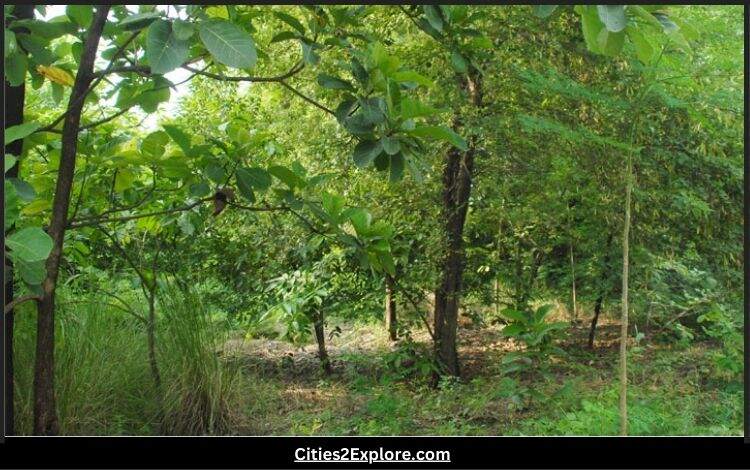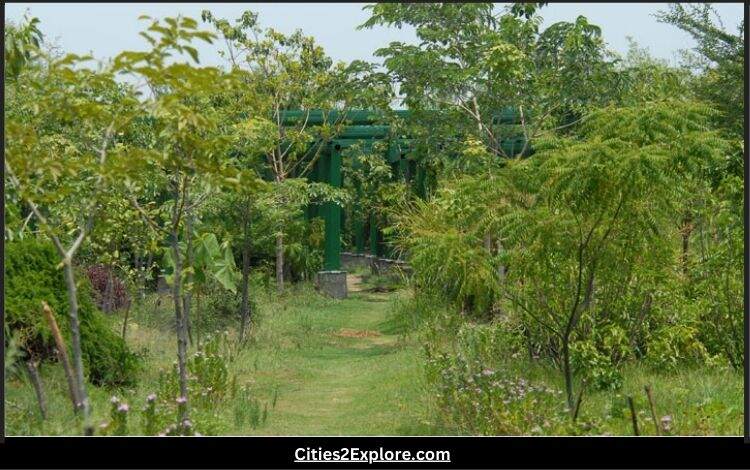The Yamuna Biodiversity Park has emerged as the most popular public place in the capital city. It serves as a prominent center for learning and understanding the environment. Within its expansive 457-acre area near Wazirabad village, located on the western bank of the Yamuna River, the park is home to diverse forest communities, rich wetlands, grasslands, and a wide variety of fruit-bearing trees and medicinal herbs.
This park also plays a crucial role in preserving native flora and fauna that had disappeared locally over the years. It acts as a natural conservation site for endangered plant species, providing a safe haven for their survival and growth. With its diverse ecosystems and natural beauty, the Yamuna Biodiversity Park offers visitors a unique opportunity to connect with nature and learn about the importance of conservation.
What is called a biodiversity park?
A biodiversity park is an area set aside for the conservation and promotion of biodiversity. It is a designated space that aims to protect and showcase various ecosystems, plant and animal species, and their ecological interactions. Biodiversity parks play a vital role in preserving natural habitats, raising awareness about biodiversity, and providing opportunities for research and education.

Yamuna Biodiversity Park Zones
The Yamuna Biodiversity Park is divided into two main zones: the visitor zone and the nature reserve zone.
The Visitor Zone
The visitor zone encompasses the front portion of the park, spanning a 220-meter stretch to the south and a 140-meter stretch to the north from the main entry gate. This area, known as the Domesticated Biodiversity Zone, is approximately 20-30 meters wide. It is marked by a hedge of poplar trees and features a variety of plants such as Ailanthus, Butea, and Bauhinia. These plants offer continuous visual interest throughout the seasons due to their long-lasting flower production. The outer iron fencing surrounding this zone is adorned with vibrant climbers like Jasmine and Quisqualis, creating a delightful and colorful ambiance.
The Nature Reserve Zone
The nature reserve zone, on the other hand, is dedicated to preserving the natural habitats and wildlife of the park. It provides a sanctuary for indigenous plants and animals, allowing them to thrive in their natural environment. This zone offers a serene and untouched space where visitors can observe and appreciate the untouched beauty of nature.
Both zones of the Yamuna Biodiversity Park provide unique experiences, whether it’s exploring the curated visitor zone with its beautiful plants or immersing oneself in the untouched tranquility of the nature reserve zone.

yamuna biodiversity park Tour
As you enter the Yamuna Biodiversity Park through the main entrance, you will come across a convenient cluster of amenities located at the southward end. Here, you’ll find three snack bars, a drinking facility, and three cozy resting places that are beautifully covered with vines of native plants. These spots provide a perfect opportunity to take a break, grab a refreshment, and relax amidst the natural surroundings.
Just beyond the entrance pocket and to the right, there is a special feature known as the “Welcome Rock facet.” This unique installation represents the origin of the Ganga and Yamuna rivers and their eventual convergence at the holy city of Allahabad. It serves as a symbolic reminder of the significance of these rivers in Indian culture and adds a touch of artistic charm to the park’s entrance area.

Following the trail within the Yamuna Biodiversity Park will lead you to several notable attractions. These include the Bambusetum, where you can explore a collection of bamboo species, the Nature Interpretation Centre, which provides insights into the park’s ecosystem, the Conservatory showcasing fruit-bearing trees, the Migratory Duck’s Wetland, and the Nature Reserve area.
On the left side of the trail, you’ll encounter a beautifully landscaped area featuring two shallow valleys that represent rangelands. These valleys showcase different ecosystems found along the Yamuna basin, extending from the foothills of the Himalayas (Siwaliks) to the point where the Yamuna and Ganga rivers meet. The first rangeland, known as Rangeland 1, is dominated by the exclusive presence of Sporobolus diander grass. The second rangeland, Rangeland 2, features a mixture of native tropical grasses such as Dichanthium, Chrysopogon, Vetiveria, and Bothriochloa. A serpentine trail borders these two rangelands.
The trail offers two loops for exploration. The first loop connects Rangeland 1 with the Herbal Garden, Sacred Grove, and Rangeland 2. Along this loop, you can enjoy the diverse flora and tranquil surroundings. The second loop leads you to the Butterfly Conservatory and the Amphitheatre. The Amphitheatre serves as an open auditorium where various events and activities are organized for visitors to enjoy.
The Herbal Garden is a special highlight, boasting a collection of approximately 450 plant species known for their healing properties. Here, you can learn about traditional medicinal plants and their uses, offering a unique opportunity to explore the therapeutic benefits of nature’s gifts.
As you follow the trail through the Yamuna Biodiversity Park, each stop presents a new and captivating experience, inviting you to discover the wonders of nature, learn about diverse ecosystems, and immerse yourself in the park’s serene and educational environment.
Exploring the Loop Trail and Nature Interpretation Centre
As you traverse the loop trail within the Yamuna Biodiversity Park, be prepared for delightful encounters with the park’s vibrant wildlife. Keep an eye out for bouncing hares, gracefully roaming the grasslands, and enjoy the sight of red-wattled lapwings and other grassland birds, adding a touch of liveliness to the surroundings. The trail offers glimpses of the park’s diverse fauna, providing opportunities for memorable wildlife sightings.
Exiting from the Butterfly Conservatory, you’ll find yourself stepping into the Sacred Grove and the Gene Bank of Petro- and Oil-yielding plants. To reach these areas, you’ll cross the Bamboo Bridge, offering a picturesque view of the resident ducks’ wetland and a wide variety of fishes swimming beneath the surface. Take a moment to soak in the tranquility and appreciate the harmonious coexistence of different species in this serene environment.
Follow the trail along the Welcome Rock Facet, and it will lead you to the Nature Interpretation Centre. This elegant classical building welcomes visitors with its attractive lighting, a red carpet floor, and captivating interior designs. Inside, you’ll find informative panels showcasing various levels of biodiversity, interactive touch screens, and visual aids that provide a deeper insight into the fundamental concepts of biodiversity. Take your time to explore the exhibits and gain a better understanding of the intricate web of life that thrives within the park.

Embarking on this loop trail and visiting the Nature Interpretation Centre guarantees a memorable and enriching experience. From close encounters with wildlife to gaining knowledge about the importance of biodiversity, each step along the way offers a unique opportunity to connect with nature and deepen your appreciation for the wonders of the Yamuna Biodiversity Park.
Ten Mounds of Ecological Diversity
Within the visitors’ area of the Yamuna Biodiversity Park, you’ll discover a fascinating display of ten mounds that offer a glimpse into the diverse forest ecosystems found along the Yamuna River Basin. These mounds represent miniature versions of the natural forests, showcasing their unique composition and structure.
Just like in nature, these forests consist of multiple layers. The towering tree canopy forms the top layer, providing shade and support for climbers that intertwine with the trees. This layer, in turn, shelters the middle storey tree layer and the shrub layer, creating a harmonious environment. Beneath these layers, the ground-cover is adorned with a variety of herbs and grasses, completing the intricate tapestry of the forest ecosystem.
Each mound is meticulously planted to mimic the structure and composition of the corresponding forest ecosystem found in its natural environment. The selection of plant species takes into consideration their roles in creating a balanced ecosystem, ensuring that the plantations on these mounds reflect the authentic characteristics of the surrounding forests.
Exploring these ten mounds is a captivating experience, allowing visitors to witness the incredible diversity and complexity of forest ecosystems along the Yamuna River Basin. It serves as a reminder of the importance of preserving and understanding the delicate balance of nature, while offering an opportunity to appreciate the beauty and functionality of these remarkable ecosystems.

Yamuna Biodiversity Park Conservatory
The conservatory within the Yamuna Biodiversity Park offers a mesmerizing display of approximately 500 varieties, representing 80 species, of fruit-yielding plants. This small area showcases the astonishing diversity found among these fruitful wonders. As you explore the conservatory, you’ll be captivated by the assortment of both familiar and unfamiliar fruits.
Species like the locally extinct Khirni (Mimusops hexandra) have made a thriving comeback, while others such as Kaith (Feronia limonia), pomegranate (Punica granatum), sapota (Achyrus sapota), jamun (Syzygium cumuni), guava (Psidium guajava), amla (Emblica officinalis), and many more add to the rich tapestry of flavors and colors.
The conservatory is not only a sanctuary for fruit-yielding plants but also attracts a variety of bird species, including parakeets, yellow-footed green pigeons, munias, babblers, coppersmith barbets, bulbuls, and peafowl, creating a vibrant avian atmosphere. Additionally, a diversity of snakes can also be found, further highlighting the thriving ecosystem within this unique space. The conservatory is a true treasure trove, showcasing the wonders of nature’s bounty and providing a fascinating glimpse into the rich biodiversity of the Yamuna Biodiversity Park.
Yamuna Biodiversity Park Herbal Garden
The Herbal Garden is like a treasure trove of living species, showcasing around 450 plants that have played important roles in human culture throughout history. It’s a lush oasis filled with diverse medicinal plants. Within its 200 seasonal changing beds and borders, you’ll find trees with healing properties, offering shelter to delicate plants. The Yamuna Biodiversity Park’s herbal garden is a delightful destination to visit all year round.

In spring, the garden comes alive with vibrant energy, as the beautiful Barlerias burst into full bloom. Summer brings the enchanting sight of Hibiscus flowers, while the monsoon season reveals the charm of Ocimum and Costus. As winter arrives, the garden showcases a magnificent display of Andrographis, Bacopa, Calendula, Aloe, and Tylophora. Overall, the garden is home to a rich collection of 434 plant species, including 120 species of trees, 280 species of shrubs and herbs, 26 species of climbers, and 8 species of grasses.
Keep an eye out for the graceful Cerulean butterfly, which can be seen fluttering over the beds of Spilanthes acmella. This area of the park is the exclusive habitat for these delicate creatures. You may also have the pleasure of spotting birds like the hoopoe, the green bee eater, and doves, which frequently visit the garden, adding their charm and melodies to the surroundings.
The Herbal Garden at Yamuna Biodiversity Park is a captivating destination where you can explore the rich heritage of medicinal plants and enjoy the beauty of nature’s wonders.
Yamuna Biodiversity Park : Butterfly Conservatory
The Butterfly Conservatory at Yamuna Biodiversity Park has become a popular destination for ecotourism, attracting visitors and nature enthusiasts alike. It offers a serene and enchanting environment for butterflies to thrive. The conservatory features four small ponds that provide moisture and create a humid atmosphere, which is ideal for butterflies.
By planting native plants, the conservatory aims to attract a multitude of wild butterflies. These delicate creatures play crucial roles as pollinators and are an integral part of the intricate web of life. They also hold cultural significance for human beings. The conservatory has carefully landscaped trees and beds of plants that resemble mixed deciduous forest communities, creating a natural habitat for the butterflies.
Unlike birds, butterflies are known to be late risers. You can spot them in large numbers later in the morning. While their population peaks in spring, you can still enjoy their presence up until the monsoon season. Currently, the conservatory is home to an impressive variety of 36 butterfly species and caterpillars.

Take a leisurely stroll through the beautifully designed butterfly conservatory and witness the blossoming of new life. In a nearby zone dedicated to larval host plants and sericulture, you can observe the fascinating transformation of caterpillars into butterflies. Don’t miss the mesmerizing sight of the tasar silk moth in action. For a peaceful and contemplative experience, there is a bamboo-made “butterfly observation shed” where you can sit and marvel at these beautiful insects as they interact with plants like Thevetia and Milkweed.
Bambusetum
The Bambusetum is a remarkable place that showcases the endurance and resilience of bamboo. It serves as a haven for specialists to study the vast diversity of bamboo species while delighting general visitors with their varied forms. You’ll encounter climbing varieties like Ochlandra, shrub-like types such as Arundinaria, tall and slender golden bamboo, and the distinctively shaped Buddha-belly bamboo.
Currently, the Bambusetum is home to 37 different bamboo species. As you explore, you might spot nests of the scaly-breasted munia and the red-vented bulbul, and if you’re lucky, you’ll catch glimpses of the common castor butterfly fluttering around the emerging young bamboo shoots.
Sacred Grove
The Sacred Grove is an area dedicated to showcasing plants of religious significance, featuring a total of 30 species of Ficus trees. In the realm of conservation, the term “Sacred Grove” refers to areas that preserve rare and endemic species. These groves are left untouched by local inhabitants due to their belief that deities reside within them. It is a place where the untouched beauty of the primary forest can still be witnessed, serving as a testament to the importance of preserving our natural heritage.
Wetlands
The Yamuna Biodiversity Park is home to two man-made wetlands that mimic natural water bodies. The first one, resembling a river, stretches 1.8 kilometers and has a long and narrow shape. The second wetland is more open and deep, covering around 2 hectares. These wetlands serve multiple important purposes. Firstly, they enhance the diversity of habitats within the park. Secondly, they play a crucial ecological role by purifying water, recharging groundwater, and storing rainwater. Lastly, they help raise the ground level, preventing flooding during the post-monsoon period, allowing the development of terrestrial ecosystems and plant communities to thrive without hindrance.
These wetlands have become a haven for numerous migratory bird species, attracting hundreds of birds from afar. Alongside these visitors, native bird species have also found a new sanctuary within the bustling environment of Delhi. Additionally, the wetlands contribute to the preservation of aquatic genetic resources, including invertebrates, turtles, fishes, and various types of plankton, thus safeguarding the river’s diverse aquatic life.

Nature Reserve Zone
Within the Yamuna Biodiversity Park, there is a serene and secluded area known as the Nature Reserve Zone. This zone is carefully managed to minimize human disturbance and provide a natural habitat for various forest communities and expansive grasslands, allowing animals to thrive and multiply undisturbed.
Covering approximately 130 acres, the Nature Reserve Zone showcases 20 distinct biotic communities. These communities include dominant species such as Adina, Mitragyna, Acacia, Hardwickia, and various types of grasslands. These diverse habitats have been created through extensive plantation efforts, and some of them have already developed dense canopies that attract a range of animal species.
As a result of these conservation efforts, the Nature Reserve Zone has become a haven for animals that were previously not found in this area. Visitors may have the opportunity to spot fascinating creatures such as monitor lizards, civets, jungle cats, and Nilgai, adding to the biodiversity and ecological richness of the park.
Nature Education
The Yamuna Biodiversity Park recognizes the significance of imparting nature education, especially to students who will become the decision-makers of the future. The park serves as an ideal learning environment, offering diverse ecosystems at different stages of development. It presents a wonderful opportunity for students to explore and understand prominent plant and animal species, seed germination, bioremediation, ecosystem restoration, food webs, and life history strategies.
Through guided educational programs, students can engage in hands-on learning experiences, gaining valuable knowledge about the natural world and the interconnectedness of various ecological processes. They can witness firsthand the importance of preserving biodiversity and the role it plays in maintaining a healthy environment.
By fostering a deeper understanding and appreciation for nature, the Yamuna Biodiversity Park aims to inspire the next generation to become responsible stewards of the environment, making informed decisions that contribute to the conservation and sustainable management of our natural resources.
Faunal Diversity
The Yamuna Biodiversity Park (YBP) provides a haven for a wide range of animal species, thanks to its diverse forest communities that offer various micro-niches and habitats. Presently, the park is home to an impressive array of approximately 2000 plant and animal species, thriving within 20-25 different biotic communities. These communities support three trophic levels and a diverse food web, including 60 species of butterflies, 50 species of dragonflies and damselflies, 200 species of birds, and various herbivores and carnivores.
The presence of specialist herbivores like the Barking deer and top carnivores such as the Leopard indicates that the ecosystem of the park is functioning well. The mosaic of wetlands within the park serves as a habitat for numerous resident and migratory bird species. The dense vegetation and the presence of large water reservoirs help regulate the local temperature and influence weather patterns in the area.

The wetlands in particular are thriving ecosystems, teeming with lush aquatic vegetation, phytoplankton, zooplankton, and fish. These serve as a valuable food source for both resident and migratory ducks. Every winter, the wetlands of YBP attract over 5000 migratory ducks from regions like Siberia, central Asia, and Europe.
Over a span of just 14 years, the Yamuna Biodiversity Park has witnessed a remarkable transformation from a highly degraded area to a thriving forest and wetland ecosystem. The increase in bird, insect, and mammal diversity is a testament to the park’s successful conservation efforts and the restoration of its natural habitats.
FAQs
What is the overview of Yamuna Biodiversity Park?
Yamuna Biodiversity Park provides a diverse and thriving natural environment in the heart of Delhi. It encompasses various ecosystems, including wetlands, forests, grasslands, and herbal gardens. The park is home to a wide range of plant and animal species, offering visitors an opportunity to connect with nature and learn about biodiversity conservation.
Why is Yamuna Biodiversity Park important?
Yamuna Biodiversity Park is important for several reasons. Firstly, it serves as a habitat for numerous plant and animal species, contributing to their conservation and biodiversity preservation. Secondly, it provides a green space in the urban landscape, offering a respite from city life and promoting environmental awareness. Additionally, the park plays a crucial role in education and research, providing opportunities for students and scientists to study ecosystems and understand their ecological significance.
What animals are in Yamuna Biodiversity Park?
Yamuna Biodiversity Park houses a diverse array of animals, including mammals like Barking deer, Leopards, and Nilgai, as well as a variety of bird species such as butterflies, dragonflies, damselflies, and migratory ducks.
Which is the nearest metro to Yamuna Biodiversity Park?
The nearest metro station to Yamuna Biodiversity Park is Wazirabad Sur Ghat Metro Station, located on the Pink Line of the Delhi Metro.
What birds are in Yamuna Biodiversity Park?
Yamuna Biodiversity Park is home to a wide variety of bird species. Some of the notable birds found in the park include hoopoes, green bee-eaters, doves, parakeets, yellow-footed green pigeons, munias, babblers, coppersmith barbets, bulbuls, and peafowl.
How many biodiversity parks are there in Delhi?
Delhi is home to several biodiversity parks. Apart from Yamuna Biodiversity Park, there are other notable biodiversity parks in Delhi, including Aravalli Biodiversity Park, Tilpath Valley Biodiversity Park, and Neela Hauz Biodiversity Park, among others.
What are the threats to Yamuna Biodiversity Park?
Yamuna Biodiversity Park faces various threats to its ecosystem, including encroachment, pollution from nearby human activities, invasive plant species, and habitat degradation. These threats can negatively impact the biodiversity and ecological balance of the park.
What are the aims and objectives of biodiversity park?
The aims and objectives of a biodiversity park are to conserve and promote the diversity of plant and animal species, protect natural habitats, raise environmental awareness, and provide opportunities for education, research, and sustainable development.
What are the characteristics of Yamuna Biodiversity Park?
Yamuna Biodiversity Park is characterized by its diverse ecosystems, including wetlands, forests, grasslands, and herbal gardens. It is also known for its rich biodiversity, with a wide range of plant and animal species, both resident and migratory.
What are the features of biodiversity park?
Biodiversity parks typically feature a variety of habitats that support different plant and animal species. They often have designated areas for wildlife conservation, educational facilities, walking trails, and signage providing information about biodiversity and environmental conservation.
Read other interesting articles:
- 11 Best Places to visit in Varanasi
- Tungnath Temple: Journey to the Highest Shiva Temple on Earth
- Exploring Majnu Ka Tila: A Journey into the Heart of Tibetan Culture
- 600 Millions Year Old Ramgarh Crater: A Window into Earth’s Geological History
- 11 Travel Essentials List You Need on Your Trip
- 7 Best Places to visit in Diwali Vacation in India
- Patna Museum : Things to Know Before Visiting
- Golghar Patna – Facts, History, Timings
- 11 Best Places To Visit in Patna
- 9 Best places to visit in Ranchi | Ranchi Tourist Attractions
- 11 Best Places to Visit in Rishikesh – Exploring City of Yoga
- Radhanagar Beach: Activities, Timings, Images & More
- Experience Royalty on Rails: Maharajas Express – The Luxury Train in India
- 11 Places to Visit in India in June: Beat the Heat and Explore!
- Buddha Smriti Park Patna: Find Inner Peace at the Heart of the City
- Explore the Pyramids of Giza: The Last Surviving Seven Wonders
- Exploring the Benefits of Traveling: Solo, Group, Health, and Educational Benefits
- Lepakshi Temple: A Jewel of Andhra Pradesh’s Heritage
- World’s Most Unique Village of Twins, Kodinhi – The Unexplained Mystery | Mystery Of Twins Village
- Murud Janjira Fort History, Images, Timing, Tourism Guide





